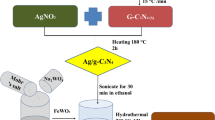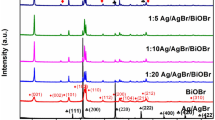Abstract
Photocatalytic technology is a green technology using solar energy, which plays an important role in environmental protection. Bismuth compound BiOX (X = Cl, Br) is an excellent wide band gap semiconductor photocatalytic material but a greatly limited absorption of visible light. Silver bromide has strong photosensitivity but poor photocatalytic performance due to the serious recombination of photoelectron-hole pairs and the potential reaction between photoelectrons and silver ions. In this work, a series of BiOBr/BiOCl/AgBr ternary composite photocatalysts with excellent photocatalytic performance is synthesized by coprecipitation, and its photodegradation property in catalytic degradation of rhodamine B (RHB) dye under visible light irradiation is investigated. The results show that BiOBr/BiOCl/AgBr ternary heterojunction is successfully prepared experimentally, and the BiOBr/BiOCl/AgBr nanocomposites with 20 % molar fraction of AgBr (molar ratio of BiOBr/BiOCl =1:1) exhibits the best photocatalytic performance, its rate is 3.6 times of BiOCl, 3.1 times of BiOBr, and 55.9 times of AgBr. The formation of S-scheme heterojunction effectively reduces the recombination of photoelectron-hole pairs, resulting in a significant improvement in the photocatalytic performance of the ternary composite catalyst.













Similar content being viewed by others
Data Availability
The data that support the findings of this study are available from the corresponding author upon reasonable request.
References
Dong SY, Feng JL, Fan MH et al (2015) Recent developments in heterogeneous photocatalytic water treatment using visible light-responsive photocatalysts: a review. RSC Adv 5(19):14610–14630. https://doi.org/10.1039/c4ra13734e
Ye L, Su Y, Jin X et al (2014) Recent advances in BiOX (X = Cl, Br and I) photocatalysts: synthesis, modification, facet effects and mechanisms. Environ Sci-Nano 1(2):90–112. https://doi.org/10.1039/c3en00098b
Weldegebrieal GK (2020) Synthesis method, antibacterial and photocatalytic activity of ZnO nanoparticles for azo dyes in wastewater treatment: a review. Inorg Chem Commun 120. https://doi.org/10.1016/j.inoche.2020.108140
Ajmal A, Majeed I, Malik RN et al (2014) Principles and mechanisms of photocatalytic dye degradation on TiO2 based photocatalysts: a comparative overview. RSC Adv 4(70):37003–37026. https://doi.org/10.1039/C4RA06658H
Wu H, Zhang L, Du AJ et al (2022) Low-bias photoelectrochemical water splitting via mediating trap states and small polaron hopping. Nat Commun 13(1). https://doi.org/10.1038/s41467-022-33905-6
Wu H, Irani R, Zhang K et al (2021) Unveiling carrier dynamics in periodic porous BiVO4 photocatalyst for enhanced solar water splitting. ACS Energy Lett 6(10):3400–3407. https://doi.org/10.1021/acsenergylett.1c01454
Wu H, Zheng ZK, Toe CY et al (2020) A pulse electrodeposited amorphous tunnel layer stabilises Cu2O for efficient photoelectrochemical water splitting under visible-light irradiation. J Mater Chem A 8(11):5638–5646. https://doi.org/10.1039/D0TA00629G
Wu H, Kong XY, Wen X et al (2021) Metal-organic framework decorated cuprous oxide nanowires for long-lived charges applied in selective photocatalytic CO2 reduction to CH4. Angewandte Chemie-International Edition 60(15):8455–8459. https://doi.org/10.1002/anie.202015735
Yang Y, Zhang C, Lai C et al (2018) BiOX (X = Cl, Br, I) photocatalytic nanomaterials: applications for fuels and environmental management. Adv Colloid Interface Sci 254:76–93. https://doi.org/10.1016/j.cis.2018.03.004
Cheng HF, Huang BB, Dai Y (2014) Engineering BiOX (X = Cl, Br, I) nanostructures for highly efficient photocatalytic applications. Nanoscale 6(4):2009–2026. https://doi.org/10.1039/C3NR05529A
Zhang K-L, Liu C-M, Huang F-Q et al (2006) Study of the electronic structure and photocatalytic activity of the BiOCl photocatalyst. App Catal B-Environ 68(3-4):125–129. https://doi.org/10.1016/j.apcatb.2006.08.002
Zhang X, Ai ZH, Jia FL et al (2008) Generalized one-pot synthesis, characterization, and photocatalytic activity of hierarchical BiOX (X = Cl, Br, I) nanoplate microspheres. J Phys Chem C 112(3):747–753. https://doi.org/10.1021/jp077471t
Liang ZY, Yang J, Zhou CX et al (2018) Carbon quantum dots modified BiOBr microspheres with enhanced visible light photocatalytic performance. Inorg Chem Commun 90:97–100. https://doi.org/10.1016/j.apsusc.2018.06.186
Hu T, Yang Y, Dai K et al (2018) A novel Z-scheme Bi2MoO6/BiOBr photocatalyst for enhanced photocatalytic activity under visible light irradiation. Appl Surf Sci 456:473–481. https://doi.org/10.1016/j.inoche.2018.02.013
Jiang R, Wu D, Lu G et al (2019) Modified 2D-2D ZnIn2S4/BiOCl van der Waals heterojunctions with CQDs: accelerated charge transfer and enhanced photocatalytic activity under vis- and NIR-light. Chemosphere 227:82–92. https://doi.org/10.1016/j.chemosphere.2019.04.038
Li X, Xiong J, Gao X et al (2020) Novel BP/BiOBr S-scheme nano-heterojunction for enhanced visible-light photocatalytic tetracycline removal and oxygen evolution activity. J Hazard Mater 387:121690. https://doi.org/10.1016/j.jhazmat.2019.121690
Wang HL, Zhang LS, Chen ZG et al (2014) Semiconductor heterojunction photocatalysts: design, construction, and photocatalytic performances. Chem Soc Rev 43(15):5234–5244. https://doi.org/10.1039/C4CS00126E
Cao J, Luo B, Lin H et al (2012) Visible light photocatalytic activity enhancement and mechanism of AgBr/Ag3PO4 hybrids for degradation of methyl orange. J Hazard Mater 217:107–115. https://doi.org/10.1016/j.jhazmat.2012.03.002
Huang D, Li J, Zeng G et al (2019) Facile construction of hierarchical flower-like Z-scheme AgBr/Bi2WO6 photocatalysts for effective removal of tetracycline: degradation pathways and mechanism. Chem Eng J 375:121991. https://doi.org/10.1016/j.cej.2019.121991
Guo F, Shi W, Wang H et al (2018) Study on highly enhanced photocatalytic tetracycline degradation of type II AgI/CuBi2O4 and Z-scheme AgBr/CuBi2O4 heterojunction photocatalysts. J Hazard Mater 349:111–118. https://doi.org/10.1016/j.jhazmat.2018.01.042
Raizada P, Thakur P, Sudhaik A et al (2020) Fabrication of dual Z-scheme photocatalyst via coupling of BiOBr/Ag/AgCl heterojunction with P and S co-doped g-C3N4 for efficient phenol degradation. Arabian J Chem 13(3):4538–4552. https://doi.org/10.1016/j.arabjc.2019.10.001
Li WT, Zou YB, Geng X et al (2017) Constructing highly catalytic oxidation over BiOBr-based hierarchical microspheres: importance of redox potential of doped cations. Mol Catal 438:19–29. https://doi.org/10.1016/j.mcat.2017.05.017
Qiu X, Lin S, Li J et al (2022) One-step coprecipitation synthesis of BiOClxBr1-x photocatalysts decorated with CQDs at room temperature with enhanced visible-light response. Inorg Chem 61(28):10999–11010. https://doi.org/10.1021/acs.inorgchem.2c01747
Zhao C, Liang Y, Li W et al (2019) 3D BiOBr/BiOCl heterostructure microspheres with enhanced photocatalytic activity. J Mater Sci: Mater Electron 31(3):1868–1878. https://doi.org/10.1007/s10854-019-02706-x
Zhang J, Lv J, Dai K et al (2018) One-step growth of nanosheet-assembled BiOCl/BiOBr microspheres for highly efficient visible photocatalytic performance. Appl Surf Sci 430:639–646. https://doi.org/10.1016/j.apsusc.2017.02.101
Miguel Ascencio-Aguirre F, Bazan-Diaz L, Mendoza-Cruz R et al (2017) Chemical synthesis and characterization of bismuth oxychloride BiOCl nanoparticles. Appl Physics a-Mater Sci Proc 123(3). https://doi.org/10.1007/s00339-017-0797-5
Bi C, Cao J, Lin H et al (2016) Tunable photocatalytic and photoelectric properties of I--doped BiOBr photocatalyst: dramatic pH effect. RSC Adv 6(19):15525–15534. https://doi.org/10.1039/C5RA22943J
Liu Y, Yuan X, Wang H et al (2015) Solvothermal synthesis of graphene/BiOCl0.75Br0.25 microspheres with excellent visible-light photocatalytic activity. RSC Adv 5(42):33696–33704. https://doi.org/10.1039/C5RA02852C
Zhang B, Hu XY, Liu EZ et al (2021) Novel S-scheme 2D/2D BiOBr/g-C3N4 heterojunctions with enhanced photocatalytic activity. Chin J Catal 42(9):1519–1529. https://doi.org/10.1016/S1872-2067(20)63765-2
Jia T, Wu J, Song J et al (2020) In situ self-growing 3D hierarchical BiOBr/BiOIO3 Z-scheme heterojunction with rich oxygen vacancies and iodine ions as carriers transfer dual-channels for enhanced photocatalytic activity. Chem Eng J 396:125258. https://doi.org/10.1016/j.cej.2020.125258
Zheng Y, Sun M, Sun W et al (2022) Nitrogen-doped graphyne/BiOBr nanocomposites: in-situ sonochemical synthesis and boosted photocatalytic performance. Sep Purif Technol 301:122062. https://doi.org/10.1016/j.seppur.2022.122062
Jia T, Yang J, Zhang Y et al (2020) Facet-dependent flower-like BiOBr with exposed the (001) and (010) facets for enhanced charge carrier transfer and photocatalytic oxidation activity. Chem Phys Lett 760:138010. https://doi.org/10.1016/j.cplett.2020.138010
Zou M, Tan C, Yang H et al (2022) Facile preparation of recyclable and flexible BiOBr@TiO2/PU-SF composite porous membrane for efficient photocatalytic degradation of mineral flotation wastewater. J Water Process Eng 50:103127. https://doi.org/10.1016/j.jwpe.2022.103127
Li H, Shang J, Ai ZH et al (2015) Efficient visible light nitrogen fixation with BiOBr nanosheets of oxygen vacancies on the exposed {001} facets. J Am Chem Soc 137(19):6393–6399. https://doi.org/10.1021/jacs.5b03105
Huang HW, Han X, Li XW et al (2015) Fabrication of multiple heterojunctions with tunable visible-light-active photocatalytic reactivity in BiOBr-BiOl full-range composites based on microstructure modulation and band structures. ACS Appl Mater Interfaces 7(1):482–492. https://doi.org/10.1021/am5065409
Hao X, Yu X, Li H et al (2020) The preparation of full-range BiOBr/BiOI heterojunctions and the tunability of their photocatalytic performance during the synthesis of imines under visible light irradiation. Appl Surf Sci 528:147015. https://doi.org/10.1016/j.apsusc.2020.147015
Cui Y, Zheng J, Zhu Z et al (2022) Preparation and application of Bi4O7/Cu-BiOCl heterojunction photocatalyst for photocatalytic degradation of tetracycline under visible light. J Mol Struct 134486. https://doi.org/10.1016/j.molstruc.2022.134486
Shan L, Liu Y, Chen H et al (2017) An alpha-Bi2O3/BiOBr core-shell heterojunction with high photocatalytic activity. Dalton Trans 46(7):2310–2321. https://doi.org/10.1039/C6DT04411E
Di J, Xia J, Ge Y et al (2014) Facile fabrication and enhanced visible light photocatalytic activity of few-layer MoS2 coupled BiOBr microspheres. Dalton Trans 43(41):15429–15438. https://doi.org/10.1039/C4DT01652A
Yin S, Di J, Li M et al (2016) Ionic liquid-assisted synthesis and improved photocatalytic activity of p-n junction g-C3N4/BiOCl. J Mater Sci 51(10):4769–4777. https://doi.org/10.1007/s10853-016-9746-5
Fang S, Zhou Y, Cui H et al (2017) Fabrication of BiOCl@CdS/Ag2CO3 heterojunctions with enhanced photocatalytic activity under visible-light irradiation. J Mater Sci-Mater Electr 28(19):14575–14583. https://doi.org/10.1007/s10854-017-7321-8
Zhao H, Liu X, Dong YM et al (2019) A novel visible-light-driven ternary Ag@Ag2O/BiOCl Z-scheme photocatalyst with enhanced removal efficiency of RhB. New J Chem 43(35):13929–13937. https://doi.org/10.1039/C9NJ01580A
Kumar Y, Sudhaik A, Sharma K et al (2023) Construction of magnetically separable novel arrow down dual S-scheme ZnIn2S4/BiOCl/FeVO4 heterojunction for improved photocatalytic activity. J Photochem Photobiol-Chem 435. https://doi.org/10.1016/j.jphotochem.2022.114326
Xie Y, Zhou Y, Gao C et al (2022) Construction of AgBr/BiOBr S-scheme heterojunction using ion exchange strategy for high-efficiency reduction of CO2 to CO under visible light. Sep Purif Technol 303:122288. https://doi.org/10.1016/j.seppur.2022.122288
Yuan F, Zheng Y, Gao D et al (2022) Facile assembly and enhanced visible-light-driven photocatalytic activity of S-scheme BiOBr/g-C3N4 heterojunction for degrading xanthate in wastewater. J Mol Liq 366:120279. https://doi.org/10.1016/j.molliq.2022.120279
Zhang Y, Di J, Zhu X et al (2022) Chemical bonding interface in Bi2Sn2O7/BiOBr S-scheme heterojunction triggering efficient N2 photofixation. Appl Catal B 323:122148. https://doi.org/10.1016/j.apcatb.2022.122148
Funding
This work was financially supported by Zhejiang provincial key R&D program (No. 2019C01088) and a joint project (No. KYY-HX-20220850).
Author information
Authors and Affiliations
Contributions
Xiao-hua Zheng was involved in the investigation and conceptualization. Wei Chen was involved in the writing and original draft. Meng-nan Xu was involved in the data curation and writing – review and editing. Chen-bin Cai was involved in the data curation and writing – review and editing. Fang-er Yang contributed to the resources and writing – review and editing. All authors reviewed the manuscript.
Corresponding author
Ethics declarations
Ethical approval
Not applicable.
Conflict of interest
The authors declare that they have no conflict of interest.
Additional information
Publisher’s note
Springer Nature remains neutral with regard to jurisdictional claims in published maps and institutional affiliations.
Rights and permissions
Springer Nature or its licensor (e.g. a society or other partner) holds exclusive rights to this article under a publishing agreement with the author(s) or other rightsholder(s); author self-archiving of the accepted manuscript version of this article is solely governed by the terms of such publishing agreement and applicable law.
About this article
Cite this article
Zheng, Xh., Chen, W., Xu, Mn. et al. Photocatalytic properties of BiOBr/BiOCl/AgBr ternary photocatalysts for degradation of RhB dye. J Nanopart Res 25, 96 (2023). https://doi.org/10.1007/s11051-023-05748-9
Received:
Accepted:
Published:
DOI: https://doi.org/10.1007/s11051-023-05748-9




